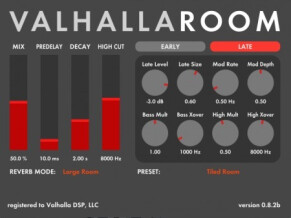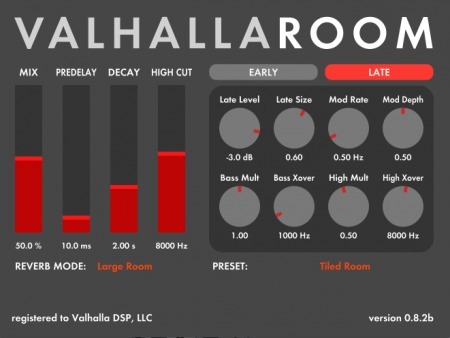Valhalla DSP has released version 1.0.6 of its ValhallaRoom reverb plug-in for Windows and Mac OS X.
In addition to a few bug fixes, version 1.0.6 introduces a new reverb mode to ValhallaRoom: Dark Room. This new reverb is designed to depart from the high fidelity path taken by the other 4 reverb modes in ValhallaRoom, according to Valhalla DSP. It is low-fi, with noisy interpolation, no high frequencies above 11 kHz, and a late reverb that can have a low initial echo density, the company says. It is also designed to have a wide stereo image, a clear decay with randomized chorusing.
Dark Room has identical controls to the other reverb modes, but produces a noticeably different initial sound. With Early Send set to 0, the Late Decay can have a marked amount of initial “flutter” or “grain, ” similar to the 224 Concert Hall with the Diffusion control set low.
A few usage tips:
- The Late Size control can be used to adjust the speed of the “flutter, ” with larger sizes corresponding to more obvious and slower echoes.
- By setting Early Send to 1.0, and adjusting the Early Size to 40 msec or later (depending on the Late Size), the flutter in the Late reverb can be totally eliminated. This is similar to how the Diffusion control works in older Lexicons, but with the advantage that the Early reverb has far less coloration than the series allpasses used for the diffusors in many “classic” reverbs. The Late Size can then be adjusted to get the desired stereo width.
- Setting DEPTH to 1.0 results in the most “vintage” sound, while values less than 1.0 allow the user to dial in some early reflections.
- With Early Send set to 1.0, and using larger Early Size values (>100 msec), the Late Reverb will have a slower initial attack. This is similar to how the Depth control worked on the 224 and 224X/L, as well as the Shape and Spread controls on the 480L and later reverbs.
- The Late High Mult and Late High Xover have an effect on the initial tone of the late decay, similar to the Concert Hall algorithm on the 224XL and the Small/Large Concert Hall B on the 224. By setting High Mult to 0.1X, the user can simulate the –6dB/octave filters used on these older boxes.
- Turn up the Early and Late Mod Depth when using Dark Room. According to Valhalla DSP, the older algorithms used a lot of pitch modulation to avoid metallic decays.
Viewers of this article also read...
-
 Rent-to-own Ozone 9 and Neutron 3 together on Splice
Splice has bundled iZotope’s latest software audio processors and offers them at a lower price through their rent-to-own program.
Rent-to-own Ozone 9 and Neutron 3 together on Splice
Splice has bundled iZotope’s latest software audio processors and offers them at a lower price through their rent-to-own program.
-
 Over 150 free software tools to make music
Making music with your computer when you don't have a penny is possible. And to prove our point here you have 150+ free software tools many of which don't have anything to envy their paid counterparts.
Over 150 free software tools to make music
Making music with your computer when you don't have a penny is possible. And to prove our point here you have 150+ free software tools many of which don't have anything to envy their paid counterparts.
-
 Over 150 free software tools to make music
Making music with your computer when you don't have a penny is possible. And to prove our point here you have 150+ free software tools many of which don't have anything to envy their paid counterparts.
Over 150 free software tools to make music
Making music with your computer when you don't have a penny is possible. And to prove our point here you have 150+ free software tools many of which don't have anything to envy their paid counterparts.





